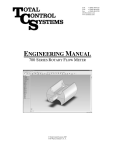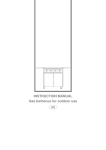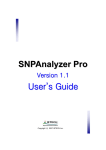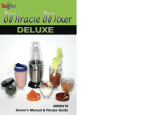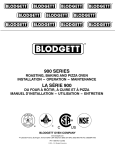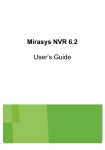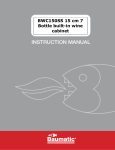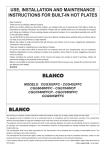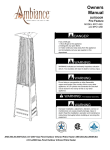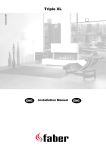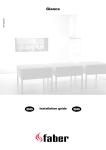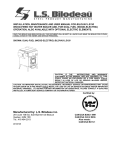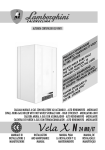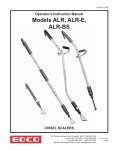Download Instructions for use
Transcript
UK GB Instructions for use Introduction 4 General safety 4 Gas safety 5 Correct use 6 EC Declaration of conformity 7 Ecological disposal 7 Model Types 8 Preliminary operations 9 Type of installation 9 Connection to the gas cylinder 10 Description of the barbecue 12 Control panel 13 Freestanding Gas Barbecue with wheels 14 Side working surface 15 Side cooking surface 16 Cooking cover 17 Protective cover 17 Using the barbecue 18 Cooking tips 20 Cleaning the barbecue 22 After-Sales Service 24 Introduction This appliance for cooking and heating food is intended for domestic use outdoors; any other use should be considered incorrect. The appliance corresponds to the conformity requirements of the CEE rules in force. These appliances are designed to come into contact with food stuffs and are constructed in compliance with EEC (CE) Regulation n. 1935/2004. This appliance is not intended for use by persons (including children) with reduced physical, sensor or mental capabilities or lack of experience and knowledge unless they have been given initial supervision or instruction concerning use of the applaince by a person responsible for their safety. Appliance class The cooking appliance described in this user manual belongs to the following installation classes: 1 and 2 subclass 1. Class 1 Cooking appliance not built in; Class 2 – subclass 1 Cooking appliance made of a single unit which can be built in between two cabinets, but which can also be installed so that the side walls are accessible. THIS MANUAL FORMS AN INTEGRAL PART OF THE APPLIANCE PURCHASED. KEEP IT THROUGHOUT THE LIFE TIME OF THE APPLIANCE. BEFORE YOU USE THE APPLIANCE WE RECOMMEND YOU READ THIS MANUAL AND ALL THE INFORMATION IN IT CAREFULLY. THESE INSTRUCTIONS ARE ONLY VALID FOR THE COUNTRIES OF DESTINATION WHOSE IDENTIFICATION SYMBOLS ARE GIVEN ON THE COVER. THE APPLIANCE IS TO BE INSTALLED BY TRAINED ENGINEERS, RESPECTING THE RULES IN FORCE. General safety • DO NOT LEAVE THE PACKAGING WASTE UNATTENDED IN THE HOME. • SEPARATE THE VARIOUS ITEMS OF WASTE MATERIAL FROM THE PACKAGING AND TAKE THEM TO YOUR NEAR-EST RECYCLING CENTRE. • THE RATING PLATE, WITH THE TECHNICAL DATA, THE SERIAL NUMBER AND THE MARKING IS POSITIONED WHERE YOU CAN SEE IT ON THE BACK OF THE APPLIANCE. NEVER REMOVE THE PLATE. • INSTALLATION AND SERVICE ARE PERFORMED BY QUALIFIED ENGINEERS RESPECTING THE RULES IN FORCE. • BEFORE USING THE APPLIANCE REMOVE THE PROTECTIVE FILMS WHICH COAT IT ON THE INSIDE AND OUTSIDE. • IMMEDIATELY AFTER INSTALLATION TEST THE APPLIANCE QUICKLY FOLLOWING THE USER INSTRUCTIONS. IF IT DOES NOT WORK PROPERLY CALL THE NEAREST CUSTOMER CARE CENTER. NEVER TRY TO REPAIR THE APPLIANCE. 4 Gas safety • GAS APPLIANCES FOR DOMESTIC USE WHICH ARE NOT CONNECTED TO A CONDUIT TO REMOVE THE COMBUSTION PRODUCTS MUST NOT PRODUCE A CONCENTRATION OF CARBON MONOXIDE WHICH COULD REPRESENT A HEALTH RISK TO PEOPLE. • IF YOU CAN SMELL GAS: - DO NOT LIGHT THE BARBECUE - RETURN ALL THE KNOBS OF THE BURNERS TO THE “OFF” POSITION - LIFT THE LID AND OPEN THE GAS CYLINDER COMPARTMENT - ROTATE THE TAP OF THE CYLINDER PIPE IN THE “OFF” POSITION - DO NOT SWITCH ON/USE ELECTRIC APPLIANCES (INCLUDING MOBILE PHONES) NEAR THE BARBECUE - CONTACT A QUALIFIED ENGINEER TO CHECK FOR ANY GAS LEAKS • NEVER USE FLAMES TO LOOK FOR ANY GAS LEAKS. • THE CONNECTION TO THE GAS PIPING MUST BE STATE OF THE ART AND CONFORM TO THE REGULATIONS IN FORCE, WHICH SPECIFY THE INSTALLATION OF A SAFETY TAP UPSTREAM OF THE GAS CONNECTION. • THIS APPLIANCE DOES NOT HAVE GAS SAFETY VALVES. DO NOT LEAVE IT UNATTENDED WHEN IT IS WORKING. IF THE FLAMES BLOW OUT ACCIDENTALLY, RETURN THE KNOBS TOTHE OFF POSITION IMMEDIATELY AND WAIT FOR A FEW MINUTES WITH THE LID RAISED BEFORE TRYING TO LIGHT THE GAS AGAIN. • THE BARBECUE CAN ONLY BE USED IN THE OPEN WHERE THERE IS NATURAL VENTILATION, NOT IN STAGNANT AREAS, SO THAT ANY LEAKS OF GAS AND COMBUSTION PRODUCTS CAN DISPERSE QUICKLY WITH THE WIND AND THE NATURAL CONVECTION OF AIR. • DO NOT USE THE BARBECUE IN ENCLOSED PLACES, CAMPER VANS, CARAVANS OR ANY OTHER MOBILE INSTALLATION. • NEVER USE THIS COOKING APPLIANCE TO HEAT ROOMS. • NEVER LEAVE INFLAMMABLE OBJECTS ON THE APPLIANCE; IF IT WERE LIT ACCIDENTALLY THEY COULD CATCH FIRE. • KEEP THIS APPLIANCE AWAY FROM INFLAMMABLE MATERIALS. • THIS APPLIANCE IS DESIGNED FOR USE WITH LPG SOLD IN SPECIAL CYLINDERS AT AUTHORISED CENTERS. • ALWAYS HANDLE EMPTY GAS CYLINDERS CAREFULLY AND RESPECTING THE SAFETY RULES SUPPLIED WITH THEIR INSTRUCTIONS. DO NOT USE GAS CYLINDERS WHICH ARE DENTED OR RUSTY. • DO NOT KEEP SPARE CYLINDERS NEAR THE BARBECUE. • NEVER DISCONNECT THE BARBECUE CYLINDER WHEN THE BARBECUE IS BEING USED AND ALWAYS REMOVE THE CYLINDER FROM THE APPLIANCE WHEN WORKING ON IT. • ONLY USE THE UNIONS AND REGULATORS SUPPLIED WITH THE APPLIANCE FOR CONNECTIONS TO THE CYLINDER. • AFTER THE APPLIANCE HAS BEEN OUT OF USE FOR SOME TIME, BEFORE USING IT AGAIN, CHECK THE GAS CONNECTION SEAL (SEE THE “CHECK FOR GAS LEAKS” SECTION ON PAGE 11) AND MAKE SURE THAT THE GAS OUTLET HOLES ARE NOT BLOCKED BY DUST OR ANYTHING ELSE (SEE “BURNER” SECTION, PAGE 23). • THE INSTALLATION AND REPLACEMENT OF DAMAGED PARTS SHALL ONLY BE CARRIED OUT BY A QUALIFIED ENGINEER OR BY THE GAS CYLINDER SUPPLIER. 5 Correct use • THE APPLIANCE IS INTENDED FOR USE BY ADULTS. DO NOT LET CHILDREN COME CLOSE TO IT OR USE IT AS A TOY. • DO NOT LEAVE THE APPLIANCE UNATTENDED DURING USE • THE BOTTOM OF THE PANS AND CONTAINERS TO BE USED ON THE GRILL MUST BE PERFECTLY SMOOTH AND REGULAR. • DO NOT USE PANS WITH A DIAMETER LARGER THAN THAT OF THE COOKING SURFACE. • ONLY LIFT THE BURNERS WITH THE GRILLING SURFACES REMOVED. • ON USING THE BARBECUE FOR THE FIRST TIME KEEP THE BURNERS LIT FOR 10 MINUTES WITH NOTHING ON THEM (WITH THE COOKING OR PROTECTIVE COVER LIFTED) TO BURN OFF ANY MANUFACTURING RESIDUES AND OILS. • BEFORE USING THE BARBECUE, ENSURE THAT THE WHITE PROTECTIVE FILM HAS BEEN REMOVED COMPLETELY. • THE BARBECUE BECOMES VERY HOT DURING USE. WEAR OVEN GLOVES TO AVOID BEING BURNT. DO NOT TOUCH THE HEATING ELEMENTS INSIDE THE APPLIANCE. • AFTER EVERY USE ALWAYS MAKE SURE THAT THE CONTROL KNOBS ARE IN THE OFF POSITION. • IF THE WEATHER IS BAD DO NOT USE THE BARBECUE. ANY CONTACT WITH WATER COULD SERIOUSLY DAMAGE THE APPLIANCE AND AFFECT ITS SAFETY. • DURING COOKING MAKE SURE THAT THE GREASE DRAIN HOLE AT THE FRONT OF THE BARBECUE DOES NOT BECOME BLOCKED. IF NECESSARY CLEAN THE HOLE WELL USING WOODEN OR PLASTIC TOOLS. THIS OPERATION IS TO BE CARRIED OUT WHEN THE APPLIANCE IS COLD AND BEFORE EACH USE. • DO NOT BLOCK THE OPENINGS AND THE VENTILATION AND HEAT DISPERSING SLITS IN THE SIDES AND BACK OF THE APPLIANCE. • TO AVOID THE BURNING OF PREVIOUS COOKING RESI-DUES, BEFORE EVERY USE CLEAN THE DRIP TRAY, THE BURNER COMPARTMENT, THE REFRACTORY CERAMIC PLATES AND THE BURNERS THEMSELVES. • AVOID THE USE OF METAL SPONGES AND CUTTING SCRAPERS ON THE EXTERNAL SURFACES. USE NORMAL NON-ABRASIVE PRODUCTS, IF NECESSARY USING WOODEN OR PLASTIC TOOLS. RINSE CAREFULLY AND DRY WITH A SOFT CLOTH. DO NOT USE HIGHPRESSURE WATER JET MACHINES ON THE BARBECUE. THE POWER OF THE WATER JET COULD DAMAGE THE APPEARANCE AND AFFECT SAFETY. • STORAGE OF AN OUTDOOR GAS GRILL APPLIANCE INDOORS IS PERMISSIBLE ONLY IF THE GAS CYLINDER IS DISCONNECTED AND REMOVED FROM THE OUTDOOR GAS GRILL. 6 EC Declaration of conformity This appliance has been designed, constructed and marketed in compliance with: - safety requirements of "GAS" Directive 2009/142/EC (ex-90/396/EEC); - safety objectives of "Low Voltage" Directive 2006/95/EC (which replaces 73/23/EEC and subsequent amendments); - protection requirements of "EMC" Directive 2004/108/EC. This appliance is suitable for contact with foodstuffs and complies with EC Regulation no. 1935/2004. Ecological disposal • NON-POLLUTING MATERIALS, WHICH ARE COMPATIBLE WITH THE ENVIRONMENT AND RECYCLABLE, HAVE BEEN USED TO PACKAGE THE PRODUCTS. DISPOSE OF THE PACKAGING CORRECTLY AT A RECYCLING CENTRE. THE MANUFACTURER DECLINES ALL RESPONSIBILITY FOR USES DIFFERENT FROM THOSE INDICATED, AND FOR DAMAGE SUFFERED BY PEOPLE AND THINGS CAUSED BY THE FAILURE TO OBSERVE THE PROVISIONS GIVEN ABOVE OR BY TAMPERING, EVEN PARTIAL, WITH THE APPLIANCE AND USING SPARE PARTS WHICH ARE NOT ORIGINAL. 7 Model Types THE BARBECUE HAS BEEN DESIGNED AND MANUFACTURED FOR THE COOKING AND HEATING OF FOOD IN THE OPEN AIR AT HOME. THIS APPLIANCE IS NOT INTENDED FOR PROFESSIONAL USE OR FOR USE INDOORS. - CAREFULLY READ ALL USER’S INSTRUCTIONS BEFORE USING THE APPLIANCE - WARNING: ALL ACCESSIBLE PARTS CAN REACH HIGH TEMPERATURES. KEEP AWAY FROM CHILDREN’S REACH. - DO NOT MOVE THE APPLIANCE DURING USE - DO NOT TAMPER WITH THE APPLIANCE OR MODIFY IT IN ANY WAY AS THIS COULD CAUSE HAZARD. Hob only version - ideal for building in Freestanding Barbecue 8 Preliminary operations BEFORE INSTALLING AND USING THE BARBECUE YOU SHOULD CLEAN ITS INNER PARTS TO REMOVE ANY MANUFACTURING RESIDUES. FOR MORE INFORMATION ON CLEANING REFER TO THE “CLEANING THE BARBECUE” CHAPTER. Choose the place where the barbecue will be installed carefully. 1) it must not be too dusty: in the long term the dust could block the burners and make use of the barbecue dangerous; 2) it must not be too exposed to the wind: during use too strong a wind could affect the correct operation of the barbecue or cause the burners to go out accidentally; 3) position the barbecue in an area where complete stability can be assured. Ensure that the wheel brakes are in place as shown on page 17 (“Freestanding gas barbecue with wheels”) and that the barbecue is used on a flat level surface. Always ensure that the appliance is in a perfectly still and stable position during cooking. Type of installation The appliance can be freestanding, placed on a shelf or fitted inside a masonry structure. Always ensure that both the following instructions and any current local regulations are fully complied with. Installation resting on a support 4 small feet are supplied, which should be screwed into the underneath of the hob. Place the hob on a level surface and level by adjusting the height of the feet. In the version supplied with 4 trolley wheels, these should be fixed with screws into the threaded seats underneath the cupboards. DO NOT USE THE BARBECUE RESTING ON A SUPPORT WITHOUT THE FEET OR THE CORRECTLY SCREWED-ON WHEELS. Built-in installation On both sides maintain a minimum distance of 50mm from the adjancent walls and from the wall to the rear, if there is one. Walls surrounding the barbeque should not be higher than the barbeque cooking surface. If a roof is to be installed over the barbeque, it must be at least 1000mm above the grilling surface. DISTANCES SMALLER THAN THESE INDICATED COULD REPRESENT A RISK FOR USER SAFETY AND CAUSE DAMAGE TO THE BARBECUE STRUCTURE. 9 Connection to the gas cylinder THE APPLIANCE IS ALREADY ADJUSTED FOR OPERATION WITH LPG. JUST CONNECT THE RUBBER PIPE WITH GASKETS AND CLIPS SUPPLIED BY THE GAS CYLINDER SUPPLIER WHEN PURCHASING THE GAS CYLINDER ITSELF, FOLLOWING THE PROCEDURE DESCRIBED BELOW. MAKE SURE THAT THE GAS PRESSURE DOES NOT EXCEED 14” WATER GAUGE. 1) Unscrew the 4 screws A and remove the rear barbecue panel. 2) Connect nut B of the gas pipe to the threaded connection C on the cylinder. 3) Connect nut D, on the other end of the gas pipe, to the threaded connection E of the barbecue. If the cylinder is housed in the trolley pass the gas pipe through the hole F (pre-shear) then connect as described in points 1 to 3. 4) When the operations are completed reassemble the rear panel screwing up the 4 screws A. WARNING: DO NOT OBSTRUCT THE GAS CYLINDER COMPARTMENT AIR VENTS. ALWAYS CLOSE THE SUPPLY VALVE OF THE GAS CYLINDER AFTER USE AT THE END OF THE CONNECTION MAKE SURE THAT THE RUBBER PIPE IS NOT SQUASHED OR SUSPENDED OR PREVENTS THE COVER OPENING. FOR METHANE OPERATION SEE THE NEAREST AUTHORISED CUSTOMER CARE CENTER. FOR ASSEMBLY OR REPLACEMENT OF THE RUBBER PIPE REFER TO THE REGULATIONS IN FORCE. THE PIPE IS PRINTED WITH THE DATE OF EXPIRY, REPLACE IT IN DUE TIME. IF THE CYLINDER DOES NOT HAVE A CLOSING VALVE, AN ON-OFF TAP SHOULD BE FITTED. THE TAP MUST BE EASILY ACCESSIBLE. - INSPECT THE GAS CYLINDER SUPPLY HOSE BEFORE EACH USE OF THE GRILL. IF THE HOSE SHOWS EXCESSIVE ABRASION OR WEAR OR IS CUT, IT MUST BE REPLACED BEFORE USING THE GRILL. - ALWAYS CHECK CONNECTIONS FOR LEAKS EACH TIME YOU CONNECT AND DISCONNECT THE L.P.GAS SUPPLY CYLINDER. 10 Connection to the gas cylinder Table of burner and nozzle properties and gas consumptions BURNERS GRILL SIDE SURFACE Rated power kW 6.20 3.30 Reduced power kW 2.20 1.30 G31 37mbar n° 127 93 G31 37mbar n° Reg. 60 NOZZLE DIAMETER G30 28..30mbar BY-PASS DIAMETER G30 28..30mbar Check for gas leaks Do this immediately after the gas is connected and every time the appliance is reconnected after it has not been used for some time. Once the rubber pipe is connected to the gas supply proceed as follows: 1) Open the gas valve on the LPG cylinder (or turn the ON-OFF tap for methane supply). DO NOT LIGHT THE BURNERS YET. 2) With the gas pressure in the pipe, look for any leaks by brushing a water-based soapy solution on the gas connections. If there are any leaks bubbles will form where the gas is escaping. BEFORE USING THE BARBECUE, ENSURE THAT THE WHITE PROTECTIVE FILM HAS BEEN REMOVED COMPLETELY. ENSURE THAT THE WHITE PROTECTIVE FILM, APPLIED ON ALL VISIBLE STAINLESS STEEL COMPONENTS TO PROTECT THEM FROM SCRATCHES, HAS BEEN REMOVED COMPLETELY. A PROTECTIVE FILM HAS ALSO BEEN APPLIED TO THE DRIP TRAY UNDER THE BURNER ASSEMBLY OF THE BARBECUE. THIS SHOULD ALSO BE REMOVED. NEVER USE NAKED FLAMES TO LOOK FOR LEAKS. 3) Close the cylinder gas valve (or the methane ON-OFF tap), deal with the gas leak and repeat the test as described in points 1 and 2. Pipe fastener terminal The trolley has a pipe fastener terminal. It must be used to avoid the gas supply pipe coming into contact with hot surfaces in the stretch from the barbecue to the connection on the cylinder. 11 Description of the barbecue A B C D E F G H I L M N O Side working surface Drip tray Heat dispersal openings Enamelled cast iron grilling surfaces Side cooking surface Plate Upper drawer Lower drawer Cylinder-holder compartment door Control knobs Wheel with brake Wheel without brake Cooking cover 12 Control panel All the barbecue commands and controls can be found on the front panel. 1 2 3 4 Left burner control knob Central left burner control knob Central right burner control knob Right burner control knob Burner control knob To light the burner refer to the “Lighting the burners” section on page 19. Description of the symbols Electronic ignition Left burner Maximum flame Central left burner Minimum flame Central right burner Burner OFF Right burner 13 Freestanding Gas Barbecue with wheels WARNING! THE INSTALLATION AND ASSEMBLY OF THE BARBEQUE COMPONENTS ENTAIL THE HANDLING OF HEAVY CUMBERSOME PARTS. IT IS RECOMMENDED THAT THESE OPERATIONS ARE CARRIED OUT BY TWO PEOPLE. PROTECTIVE GLOVES SHOULD BE USED DURING ALL ASSEMBLY OPERATIONS. In 18/10 stainless steel. It has two fixed wheels and two pivoting wheels with brake. It acts as a cylinderholder compartment but depending on its width can be fitted with drawers or extra compartments. Cylinders not more than 50 cm tall (with the pressure regulator mounted) can be housed under the trolley support surface. The pressure regulator outlet should be mounted horizontally. Assembly and use of the wheels Screw on the 4 wheels, in the threaded seats under the structure, with the four hexagonal M8 bolts supplied. To brake the barbecue just use the foot-operated trip lever as shown in the figure. To unlock the brake release the lever and allow it to return to the rest position. Both revolving wheels fitted with brake should be fitted on the left side, while the fixed wheels should be fitted on the right side (gas cylinder compartment side), as shown in the section "Description of the barbecue". DO NOT USE THE BARBECUE IF THE WHEELS ARE NOT CORRECTLY ATTACHED. Fastening the hob to the trolley BEFORE PERFORMING THIS OPERATION INSTALL THE PIVOTING WHEELS (SEE INSTRUCTIONS ABOVE), EXTRACT THE DRAWERS AND OPEN THE CYLINDER-HOLDER TROLLEY DOOR. Screw the trolley to the top using four hexagonal M10 bolts which screw to the bottom of the top from inside the trolley. Adjusting the door The door hinge can be adjusted by means of the adjusting screws shown by the arrow in the diagram to the right. ADJUST THE DOOR AT THE END OF THE INSTALLATION. 14 Side working surface In stainless steel with working area. It is fastened to the barbecue structure. THE SIDE WORKING SURFACE IS DESIGNED TO BEAR A MAXIMUM LOAD OF 20 KG. Assembly instructions • Partially screw screws A (hexagonal M5, 4 per side) with washers into the threaded inserts on the side of the barbecue. • Slide the lateral surfaces into the slots B and then press downwards. • Fully tighten screws A. 15 Side cooking surface In stainless steel with 3.5 kW triple-crown burner with cast iron grill. It is fastened to the barbecue structure. The ignition is electronic. The gas connection is in series with the barbecue burners. A cover is supplied which protects the burner when it is not used. THIS PROTECTIVE COVER IS NOT DESIGNED FOR COOKING FOOD. ALWAYS REMOVE IT BEFORE LIGHTING THE BURNER.THE COVER IS FITTED WITH A MECHANICAL LOCKING DEVICE TO PREVENT ACCIDENTAL FALL. TO LOCK: FROM THE VERTICAL POSITION, PRESS THE COVER DOWN. TO UNLOCK: PULL UPWARDS AND ACCOMPANY THE COVER UNTIL IT CLOSES. NEVER LET THE COVER FALL FREELY. For structure assembly refer to the “Side working surface” instructions on page 15. Connecting the cooking surface gas THE APPLIANCE IS ALREADY ADJUSTED FOR OPERATION WITH LPG. JUST CONNECT THE RUBBER PIPE WITH GASKETS AND CLIPS SUPPLIED AS DESCRIBED BELOW MAKING SURE THAT THE GAS PRESSURE DOES NOT EXCEED 14” WATER GAUGE. 1. 2. 3. 4. 5. 6. Connect one end of pipe A to threaded connection D on the cylinder. Use the pre-sheared hole to lead pipe A under the cooking surface. Connect the other end of pipe A to threaded connection E. Connect one end of pipe B to threaded connection F on the barbecue Use the presheared hole to lead pipe B under the cooking surface. Connect the other end of pipe B to threaded connection C. A metal clip must be fitted in the points of the drawing marked with the symbol. AT THE END OF THE CONNECTION MAKE SURE THAT THE RUBBER PIPE IS NOT SQUASHED OR SUSPENDED OR PREVENTS THE COVER OPENING. PANS WITH MINIMUM DIAMETER 20 CM AND MAXIMUM DIAMETER 26 CM CAN BE POSITIONED ON THE SIDE COOKING SURFACE. DIFFERENT DIMENSIONS COULD BE DANGEROUS TO THE USER AND/OR AFFECT THE GOOD USE OF THE APPLIANCE. Triple-crown burner control knob To light the burner refer to the “Lighting the burners” section on page 19. 16 Cooking cover In stainless steel with handle. Can be used for cooking and keeping food warm. DURING COOKING THE COVER BECOMES VERY HOT. WEAR OVEN GLOVES WHEN HANDLING IT. Assembly instructions • Put the tabs (one per side) of cover A into the slots on the inner side of the barbecue, as shown by the arrow in the detail in the figure. Protective cover In stainless steel. Its function is to protect the burners when the barbecue is not being used. UNLIKE THE “COOKING COVER” THIS PROTECTIVE COVER IS NOT DESIGNED FOR COOKING FOOD. ALWAYS REMOVE IT BEFORE LIGHTING THE BURNERS. 17 Using the barbecue Examples of use The outside positioning area must have the following features: 1. walls on all sides, but at least one permanent opening and no covering of the top; 2. covering of the top but not more than two side walls; 3. a partial closure which includes covering of the top but not more than two walls and with the following restrictions: a) At least 25% of the total wall surface will be completely open. b) At least 30% of the remaining surface will be open and not confined. If the barbecue is placed on a balcony or terrace at least 25% of the total wall surface must be open. Positioning the internal components Before starting to cook check that the burners, spreaders, grills and rack are correctly positioned. The figure shows the correct sequence for positioning burners A, spreaders B, grills C and rack D. • The tabs of spreader B are slotted into slots E on the internal barbecue steel sheet. COOKING IS ONLY ALLOWED IN THE CONDITIONS SHOWN IN THE FIGURE, WITH ALL THE ABOVE-MENTIONED COMPONENTS MOUNTED CORRECTLY. ANY OTHER CONFIGURATION WOULD BE DANGEROUS TO THE USER AND COULD AFFECT THE PROPER USE OF THE APPLIANCE. 18 Using the barbecue Lighting the burners Each control knob indicates the associated burner (see “Control panel”, page 13). The example to the side shows the central left burner. 1. Press the control knob and turn the indicator to the symbol:: an ignition spark is generated and the pilot flame lights. To generate further sparks keep the control knob pressed turning the indicator repeatedly in correspondence to the symbol. 2. When the burner is lit turn the control knob indicator to the position. Release the control knob: the burner is now at maximum heat. 3. To adjust from maximum heat to minimum heat turn the control knob indicator from the position to the position. 4. To turn the burner off turn the control knob indicator to the position; press the control knob and, keeping it pressed, turn the indicator to the position (burner off). Release the control knob. IF THE BURNER DOES NOT LIGHT, TURN THE CONTROL KNOB INDICATOR BACK TO THE CONTROL KNOB AND KEEPING IT PRESSED RETURN THE INDICATOR TO THE POSITION (BURNER OFF). WAIT FOR A FEW SECONDS TO ALLOW THE GAS IN THE ATMOSPHERE TO DISPERSE AND THEN REPEAT POINTS 1 TO 3. 19 ; PRESS Cooking tips A few suggestions for getting the best out of your barbecue are given below. Remember however that the cooking times and intensities proposed may not be to your taste. Direct cooking: this is when the food cooks directly on the grill under which the burner is lit. Indirect cooking: this is when the food cooks on the grill next to the one with the lit burner. LEAVE THE “PROTECTIVE COVER” OPEN DURING COOKING. POUR SOME WATER INTO THE DRIP TRAY TO COOK MORE GENTLY AND FOR EASIER CLEANING LATER Meat To cook meat we recommend preheating the grills with the burners set at maximum for 5-10 minutes, depending on how thick the meat is. For small pieces (chops, slices of bacon, ribs, etc.) a short preheat is recommended (about 5 minutes). For larger pieces (Joints, whole chicken etc) a longer preheat is required (about 10 minutes). In both cases preheat with the cover lowered. Direct cooking In general for the direct cooking of meat the burners should be set to maximum, while for fish and vegetables the burners should be set to medium or low. Generally for good cooking start grilling the food with the burners set on maximum. Once the outside of the food is cooked, reduce the burner heat to medium, or low so that the food can cook on the inside, without burning the outside. During cooking, particularly with pork, or lamb, it is normal to have flames on the grill due to the dripping of fat onto the refactory ceramic plates. Just move the food to a cooler area of the grill. We recommend that you do not fill the grill with food whilst cooking. Indirect cooking After preheating the grill, with the burners set at maximum and with the cooking cover closed, position the food on the side of the grill nearest, but not over the lit burner. With the 90cm barbecue, light the side burners and place the food on the central grill. Start the cooking with the burner set to minimum then increase the heat gradually. This cooking method will take considerably longer than with direct cooking, but a good result will be obtained. This type of cooking is more suited to large pieces of meat (Joints or whole chicken) and fish (sea bream mackerel etc), or thick fatty foods, which could catch fire with direct cooking, as fat can drip onto the refactory ceramic plates. Vegetables For vegetables, like meat, it is a good idea to preheat the burners to the maximum (for 5/10 minutes) with the cooking cover closed. Direct cooking At the end of the preheating phase, adjust the burners to minimum and place the vegetables on the grill. Because vegetables have a tendency to burn easily, we suggest the burners are set on minimum throughout grilling. 20 Cooking tips Burner use diagram TEMPERATURE SETTING THE BURNERS USE 230 - 250 °C Maximum position ( ) 200 °C Average-maximum position Medium-high heat. For direct cooking of thin cuts of meat, fish and vegetables. 160-180 °C Intermediate position Medium heat. To cook medium cuts of meat (half chicken, devilled chicken, etc.). Also suitable for indirect cooking. 150 °C Average-low position Medium-low heat. For indirect cooking or for smoking; to reheat meals or keep just cooked meals warm. 110-120 °C Minimum position ( ) Low heat. To smoke and cook large pieces of greasy or delicate foods; to grill vegetables; to keep just cooked meals warm. High heat. Preheating before starting to cook. Quick cooking indications • Always preheat with the burners on maximum. • When cooking on the plate it is a good idea to preheat for 15 minutes. • In cooking which requires a more marked grilling preheat for 15 minutes. • In indirect cooking preheat by lighting the burner near the food positioned on the grill for 5 minutes and the remaining burners at maximum for 10 minutes. Cook with the cover closed. • In direct cooking (meat or fish) if the strong heat tends to burn the meals, lower the burner intensity or move the food to a cooler area of the grill. 21 Cleaning the barbecue For the best cleaning, respecting the appliance’s manufacturing features, we recommend the use of products which are not excessively aggressive. Before carrying out any cleaning operations ensure that the appliance is off and the parts to be cleaned are cold. Always use protective oven gloves when handling the various parts, as these may be hot WEAR WORK GLOVES TO CLEAN THE INTERNAL PARTS. Stainless steel After every use, to look after the barbecue, we recommend you clean the external and internal parts and the stainless steel accessories regularly, after the appliance has been left to cool. To clean and look after the stainless steel external surfaces always use a specific stainless steel product which does not contain any abrasives, or chlorine-based acids. Do not use metal sponges, or metal scrapers, as these will scratch the steel. If necessary use wooden or plastic tools. Use of detergent: spray the detergent on the barbecue steel surfaces several times. Clean with a nonabrasive sponge, rinse thoroughly and dry with a soft cloth. For best results leave the detergent to act for a long time. To avoid any yellowing of the steel pour stainless steel cleaning products on a piece of kitchen towel and rub following the direction of the satin finish. Internal components The racks and plate in enamelled cast iron Clean the cast iron grills A and plate B when they are still warm. To remove any residues of food wipe with a brass-bristled brush. Finish the cleaning by washing the grills and plate with a degreasing detergent and rinse with plenty of lukewarm water. Over time the continuous contact with the flame can cause an alteration of the steel’s brightness near the areas exposed to heat. This is a completely natural phenomenon which does not affect the barbecue’s working. To limit the yellowing of the steel we recommend the use of stainless steel cleaning products applied with a nonabrasive sponge. The cast iron grills and the plate can also be washed in the dishwasher. AFTER CLEANING THOROUGHLY AND BEFORE USING THE CAST-IRON GRILLS AND THE PLATE AGAIN REMOVE ANY RESIDUES OF DETERGENT BY KEEPING THE BURNERS LIT AT MAXIMUM FOR A FEW MINUTES. 22 Cleaning the barbecue Burners Check regularly that the burners light properly and that none of the gas outlet holes are blocked. Whenever a burner does not light completely, just blowing compressed air may be enough to free the blocked holes of dust or other. If this is not effective, disassemble the burner and clean it more thoroughly (e.g. poking a needle into the blocked holes and blowing compressed air directly inside the burner). Disassembling the burners • Extract grills A and plate B. • Extract spreaders C. • To extract burners D remove cotter pins F (one for each burner); then free the Venturi pipe from the socket and extract. • Extract deflectors E. • Clean the barbecue basin with a stainless steel cleaning product. Rinse and dry. • Clean the individual components carefully and reassemble proceeding in reverse. Drip tray At the end of cooking (after leaving the barbecue to cool) take out the drip tray as shown in the figure to the side and pour the greasy residues into a sealed container so that they can be disposed of. DO NOT THROW THE GREASY RESIDUES FROM COOKING DOWN THE DRAIN, B UT DISPOSE OF THEM IN SEALED CONTAINERS AT THE NEAREST OIL RECYCLING POINT. • Clean the drip tray with non-abrasive products and replace. WARNING: DURING MANUFACTURING THE DRIP TRAY IS COVERED WITH A WHITE PROTECTIVE FILM. THIS PROTECTIVE FILM SHOULD BE REMOVED COMPLETELY DURING ASSEMBLY AND ALWAYS BEFORE THE BARBECUE IS USED FOR THE FIRST TIME. 23 After-Sales Service Before contacting the After-sales Service: Switch the appliance on again to see if the problem has been eliminated. If it has not, switch off the appliance and repeat the operation after one hour. If your appliance still does not work properly after carrying out the checks listed in the troubleshooting guide and switching the appliance on again, contact the After-sales Service, clearly explaining the problem and specifying: • the appliance type and serial number (given on the rating plate). • the type of fault. • the model. • the Service number (the number after the word SERVICE on the rating plate inside the appliance). • your full address. • your telephone number and area code. 24 Printed in Italy 06/10 5019 744 02027/A n




























